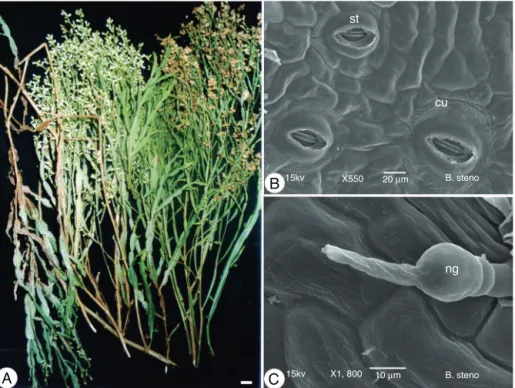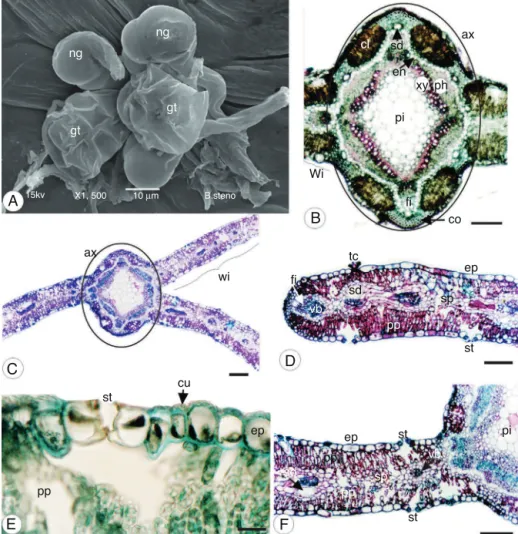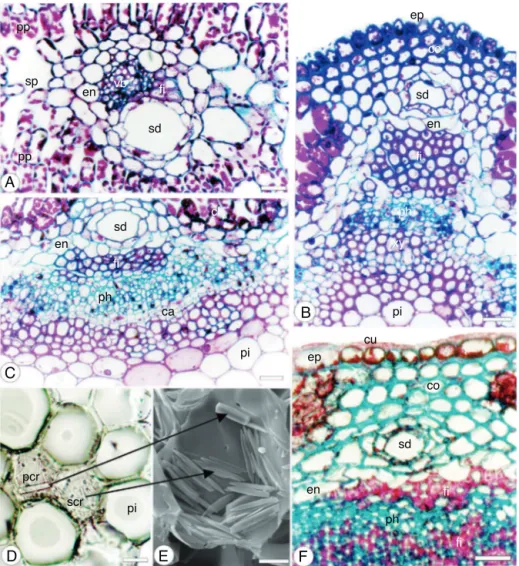w w w. s b f g n o s i a . o r g . b r / r e v i s t a
Original
Article
Pharmacobotanical
study
of
Baccharis
pentaptera
Jane
Manfron
Budel
a,
Josiane
Padilha
de
Paula
a,
Vera
Lucia
Pereira
dos
Santos
b,
Celia
Regina
Cavichiolo
Franco
c,
Paulo
Vitor
Farago
a,∗,
Márcia
do
Rocio
Duarte
daDepartamentodeCiênciasFarmacêuticas,UniversidadeEstadualdePontaGrossa,PontaGrossa,PR,Brazil bDepartamentodeEngenharia,SaúdeeMeioAmbiente,CentroUniversitárioInternacional,Curitiba,PR,Brazil cDepartamentodeBiologiaCelular,UniversidadeFederaldoParaná,Curitiba,PR,Brazil
dDepartamentodeFarmácia,UniversidadeFederaldoParaná,Curitiba,PR,Brazil
a
r
t
i
c
l
e
i
n
f
o
Articlehistory:
Received16May2015 Accepted7July2015 Availableonline29July2015
Keywords:
Compositae Herbaldrugs Medicinalplant Morpho-anatomy
a
b
s
t
r
a
c
t
BaccharisL.sect.Caulopterae,Asteraceae,comprisesthirtyspeciesinBrazilthatshowstemsrepresented bycladodes,whichareverysimilarinmorphology.Thesespeciesarepopularlyknownas“carqueja” inBrazilandArgentinaandareusedinpopularmedicineasdiureticandstomachic.Theaimofthis workwastoexaminethemorpho-anatomicalcharactersofcladodesofBaccharispentaptera(Less.)DC. fordiagnosispurposes.Theplantmaterialwaspreparedbylightandscanningelectronmicroscopy.B. pentapterashowsoppositeandspreadwingsinthetwo-wingedcladodeaxisandirregulararrangement inthethree-wingedcladode.Thewingshaveauniseriateepidermiswithpalisadeparenchymanextto bothsidesofepidermis.Thespongyparenchymacrossedbyminorcollateralvascularbundlesisobserved inthecentralregionofwings.Theglandulartrichomesarecapitateandbiseriateandthenon-glandular trichomesareuniseriateandflagelliformwith2–3cellsthatextendfromthebase.Incaulinaraxis, thereareuniseriateepidermis,chlorenchymaalternatingwithangularcollenchymaandperivascular fibercapsadjoiningthephloemwhichisoutsidethexylem.Prismaticandstyloidcrystalsareverified intheperimedullaryzone.ThesecombinedcharacterscanassistthediagnosisofBaccharisspeciessect. Caulopterae.
©2015SociedadeBrasileiradeFarmacognosia.PublishedbyElsevierEditoraLtda.Allrightsreserved.
Introduction
BaccharisL.sect.CaulopteraeincludesOrganensis,Trimeraand
Genistelloidesgroups(Heidenetal.,2009).Thissectionoccursin SouthernAmericaandcomprisesthirtyspeciesinBrazilthatshow stemsrepresentedbycladodes(Heidenetal.,2009)whichare simi-larinmorphology(Budeletal.,2008).Inthatsense,agreatefforthas beendevotedtoexaminetheanatomicalcharactersofaerial veg-etativeorgansfromBaccharisfordiagnosispurposes.Inaddition, thesespeciesareusedinpopularmedicineasdiureticand stom-achicandarepopularlyknownas“carqueja”inBrazilandArgentina
(Budeletal.,2008).
Baccharis pentaptera (Less.) DC., Asteraceae, is a shrub that inhabits exclusively Southern America. The scientific names
BaccharisstenocephalaBakerandBaccharisfastigiataBakerare con-sideredsynonymsofB.pentapteraduetoseveralupdatesprovided bytaxonomists(Schneideretal.,2009).InspiteofB.pentaptera
is not officially accepted in national pharmacopoeias, Baccharis
∗ Correspondingauthor.
E-mail:pvfarago@uepg.br(P.V.Farago).
trimera(Less.)DC.,aquitesimilartaxonthatiswidelysoldin phar-macies,herbalandstreetshops,isclaimedtobethemostpopular andinvestigatedspeciesof“carquejas”andisincludedin Farma-copeiaBrasileiraV(2010).
B.pentapteraisusedinfolkmedicinesimilarlytoother “car-quejas”(BarrosoandBueno,2002).However,ithasbeenusually mistaken for B. crispa Spreng., B. microcephala (Less.) DC., B. opuntioides Mart.ex Baker, B. trimera (Less.)DC., and B. usterii
Heering (Barroso and Bueno, 2002; Alonso and Desmarchelier,
2006;Rodrigues et al.,2008).Moreover,few studies were
per-formedinordertoinvestigatechemicaldifferencesamongspecies from Caulopterae section. Regarding B. pentaptera, Bona et al.
(2002) showed that its essential oil yielded 1.8% and
Simões-Piresetal.(2005)identified-pinene(41.3%)asitsmainvolatile
compound.
Consideringthatmedicinalplantsarewidelysoldasfragments orpowders,morpho-anatomical descriptionisthefirst parame-terthatcanbeusedfordiagnosis.Inthiscontext,morphological andanatomicalcharacterizationcanbeasimpleandfasttoolfor identificationofherbaldrugs.Thus,thegoalofthispaperwasto dis-cussthesefeaturesforcladodesofB.pentapterainordertoprovide furtherdataaboutCaulopteraesection.
http://dx.doi.org/10.1016/j.bjp.2015.07.007
A
C
B
15kv15kv
X550
X1, 800 10 µm
20 µm B. steno
B. steno
st
cu
ng
Fig.1. Baccharispentaptera(Less.)DC.,Asteraceae.(A)Generalaspect;(B)faceviewofepidermalcells,stoma(st)andstriatedcuticle(cu)bySEM;(C)surfaceviewof epidermisshowingflagelliformnon-glandulartrichome(ng)(SEM).Bar=0.5cm(A).
Materialsandmethods
Plantmaterial
Baccharispentaptera(Less.)DC.,Asteraceae,wascollectedfrom specimensof sunnyareasatFazendaSão MaximianoinGuaíba (coordinates30◦10′Sand51◦20′W,and27maltitude),Serrado
Sudoeste, Rio Grande do Sul, Brazil during December 2003. A voucherwasidentifiedbytaxonomistsandregisteredunderthe numberICN128450intheherbariumattheInstituteofBiosciences, FederalUniversityofRioGrandedoSul.
Morpho-anatomicalassays
Cladode fragments were collected 5–15cm from apex. At least five specimens were fixed in FAA 70 (Johansen, 1940), which wasreplaced by70% ethanol (v/v)(Berlyn andMiksche, 1976).Theplantmaterialwassectionedbyhandordehydrated, embeddedinglycolmethacrylate(Leicahistoresin)andsectioned usingtheLeicaRM-2145microtome.Cross-sectionsand longitu-dinal sectionswere stained withtoluidine blue (O’Brien et al., 1964) or astra blue and basic fuchsine combination (Roeser,
1972).
Thefollowingstandard solutionswereusedfor microchemi-caltests:hydrochloricphloroglucintoreveallignin(Sass,1951), SudanIIIforlipophiliccompounds(Foster,1949),ferricchloride forphenolicsubstances(Johansen,1940),sulphuricacidfor cal-ciumoxalatecrystals(Oliveiraetal.,2005)andiodine-iodidefor starch(BerlynandMiksche,1976).Photomicrographsweretaken withtheOlympusBX-40lightmicroscopeequippedwithadigital camera.
Fortheanalysisbyscanningelectronmicroscopy(SEM)(Souza, 1998),thefixedmaterialwasdehydratedusingincreasingamounts ofethanolandtheCO2criticalpointapparatus(BalzersCPD-030)
andcoatedwithgold(BalzersSputteringSCD-030).Electron micro-graphsweretakenwiththeJeolJSM-6360LVscanningmicroscope.
Results
ThestemofB.pentaptera(Less.)DC.(Fig.1A)usuallygrowstoa heightof0.5–1mandshowsthreewings(Fig.2C)inthevegetative axisandtwowingsinthereproductivebranches(Fig.2B).Theaxis isrigidandthewingsarediscontinuous.Thewingsareopposite andspreadintheaxisofthetwo-wingedcladode(Fig.2B);they areirregularlyarrangedinthecladodewiththreewings(Fig.2C).
Inthewings,theepidermalcellsarepolygonal(Fig.1BandC) andhavethickanticlinalwallswithevidentprimarypitsinfrontal view.Anomocyticstomata(Fig.1B)arelocatedatthesamelevelor slightlyabovethesurroundingcells.Incross-section,theepidermis isuniseriate(Fig.2D–F)andcoatedwithathinandslightlystriated cuticle(Figs.1B,Cand2E).Inparticular,cuticleisstriatedaround stomata(Fig.1B).
Glandular (Fig. 2A) and non-glandular trichomes
(Figs. 1C and 2A) are inserted in the same small epidermal
depressionsandareeitherisolatedorinclusters(Fig.2AandD). Theglandulartrichomes(Fig.2A)arecapitateand biseriateand have8cellsatthebase.Thenon-glandulartrichomesareuniseriate andflagelliformwith2–3cellsthatextendfromthebase(Fig.1C). Bothglandularandnon-glandulartrichomesshowcellsatthebase withdensecytoplasmandanevidentnucleusthatwerestained positivelyforlipophilicsubstances.
ng
ng
gt
gt
15kv X1, 500 B.steno
Wi
fi co
ep tc
sd
cu
ep
sd
pp
sp
vb
pi
pp
ep st
st st
pp
sp
st
vb
pp
fi wi
ax
pi en sd
ph ax
xy
cl
10 µm
A
C
E
F
D
B
Fig.2.Baccharispentaptera(Less.)DC.,Asteraceae.(A)Surfaceviewofepidermalcellsexhibitingbiseriateglandulartrichomes(gt)andnon-glandulartrichomes(ng)in clusterbySEM;(B)cladodeincross-sectionshowingaxis(ax),chlorenchyma(cl),collenchyma(co),endodermis(en),fibers(fi),pith(pi),phloem(ph),secretoryducts(sd), xylem(xy)andtwowings(wi);(C)cladodeincross-sectionindicatingaxis(ax)andthreewings(wi);(D)wingincross-sectionneartothebordershowingepidermis(ep), fibers(fi),palisadeparenchyma(pp),spongyparenchyma(sp),stoma(st),trichomesinclusters(tc)secretoryduct(sd)andvascularbundle(vb);(E)wingincross-section showingcuticle(cu),epidermis(ep),stoma(st)andpalisadeparenchyma(pp);(F)wingandaxisindicatingepidermis(ep),palisadeparenchyma(pp),spongyparenchyma (sp),stoma(st),secretoryduct(sd),vascularbundle(vb)andpith(pi).Bar=20m(E),100m(B,D,F),200m(C).
In stem axis,the epidermis exhibits similar features to the wingsand, below it;thechlorenchymaalternates withangular collenchyma,whichhas2–3rowsintheribs(Figs.2Band3B,F). Secretoryducts,similartothoseviewedinthewings,canbefound nextto endoderm that bounds the internal part of the cortex
(Figs.2Band3B,C,F)anditswallsareimpregnatedwithlipophilic
compounds.
Thevascular cylindershowscambium thatproduces inward xylem and outward phloem (Fig. 3B and C). Perivascular fiber capsareadjoiningtophloemandsomefiberscanalsoappearin phloem(Fig.3B,CandF).Thepithiscomposedbyrelativelylarge parenchymatouscells withthinwalls(Fig.3B–D).Prismaticand styloidcrystals(Fig.3DandE)ofcalciumoxalateoccurinthe per-imedullaryregion.
Discussion
Baccharis L.sect. Caulopterae comprises shrubs withwinged stems (Heiden et al., 2009) that can be either continuous or discontinuous and form different-sized segments (Barroso and
Bueno,2002).Inthissection,thereareseveralspecieswhichshow
three-winged vegetative and reproductive branches, suchas B. apicifoliosaA.A.Schneid.&Boldrini,B.crispaSpreng.,B. flexuosir-amosaA.A.Schneid.,B.glazioviiBaker,B.jochenianaG.Heiden& Macias,B.junciformisDC.,B.microcephala(Less.)DC.,B.milleflora
(Less.)DC.,B.myriocephalaBakerandB.penningtoniiHeering.The speciesB.articulata(Lam.)Pers.presentstwo/three-winged veg-etativebranchesandtwo-wingedreproductivecladodes(Heiden etal.,2009).Inthisstudy,B.pentaptera(Less.)DC.showedthree wingsinthevegetativeaxesandtwowingsinthereproductive branches.
TheepidermalcharacteristicsstablishedforB.pentapteraare observedinmostof“carquejas”(Cortadietal.,1999;Budeletal.,
2003,2004;BudelandDuarte,2010;Pereiraetal.,2014;Jasinski
etal., 2014), includingthe anatomicalpattern of anticlinal epi-dermalcellswalls.Anomocyticandanisocyticstomataareusually describedforseveralspeciesofBaccharis(Souzaetal.,2011,2013;
Budeletal., 2013;Jasinski etal.,2014).However,Pereira etal.
(2014)verifiedactinocyticandanomocyticstomataforB.milleflora
DC.Actinocyticstomatawerealsofoundonlyinthenon-wingedB. confertaKunthandB.boliviensis(Weed)Cabrera(Freireetal.,2007).
Freireetal.(2007)reportedthatthestomataltypeandepidermal
cellwallscanbeusedtodifferentiateBaccharisspecieswhenthey havesimilartrichomes.
Biseriatecapitateglandulartrichomesaretypicallyregistered for“carquejas”.Similartrichomeswerereportedinmanyspecies ofBaccharis,suchasB.coridifoliaDC. (Budeland Duarte,2007),
pp
sp
en
sd
sd
ph
ca
pi
pi pcr
scr
ep
cu pi
co
sd
fi
fi
en
ph en
fi
cl
sd ep
fi co
ph
xy
en
pp
A
C
D
E
F
B
vb fi
Figure3. Baccharispentaptera(Less.)DC.,Asteraceae–Cladodeincross-section.(A)Detailofwing,showingaminorvascularbundle(vb),endodermis(en),fibers(fi),palisade parenchyma(pp),spongyparenchyma(sp)andsecretoryduct(sd).(B)Axisindirectiontocollenchyma(co)exhibitingepidermis(ep),endodermis(en),fibers(fi),secretory duct(sd),phloem(ph),xylem(xy)andpith(pi).(C)Axisindirectiontochlorenchyma(cl)indicatingcambium(ca),endodermis(en),fibers(fi),secretoryduct(sd),phloem (ph),xylem(xy)andpith(pi).(D)Prismatic(pcr)andstiloid(scr)crystalsofcalciumoxalateinthepith(pi).(E)Prismaticandstyloidcrystalsofcalciumoxalateinpith(SEM). (F)Axisshowingfibers(fi)inphloem(ph),cuticle(cu),collenchyma(co),secretoryduct(sd),endodermis(en)andepidermis(ep).Bar=20m(A–E).
B.notosergilaGriseb.,B.pedunculata(Mill.)Cabrera(Heidenetal., 2009),B.teindalensisKunth,B.tolaPhil.(Freireetal.,2007),and
B.usteriiHeering(BudelandDuarte,2010).Moreover,other gen-eraofAsteraceaehavetheseglandulartrichomes,mainlyGochnatia
(Youssef etal.,2013), Calea(Budelet al.,2006; Camilottietal.,
2014)andMikania(Gasparettoetal.,2010;Amorinetal.,2014;
Araújo et al., 2015).Furthermore, other types of glandular
tri-chomeswerealsodescribedfor“carquejas”asuniseriatecapitate glandulartrichomesinB.sagittalis(Less.)DC.andB.triangularis
Hauman(Petenattiet al.,2007)and non-capitate glandular tri-chomesinB.usterii(BudelandDuarte,2010).
Thenon-glandulartrichomesobservedinthisstudywerefound for both winged and non-winged species, suchas B. coridifolia
(BudelandDuarte,2007),B.anomalaDC.(BudelandDuarte,2008a),
B. singularis (Vell.) G.M. Barroso (Souzaet al., 2011), B. spicata
(Oliveiraetal.,2011),B.cognataDC.(Budeletal.,2013),B.glaziovii
(Jasinski et al., 2014) and B. milleflora (Pereira et al., 2014). In
addition,simple and flagelliform non-glandulartrichomes with uniseriateisodiametric cells at thebaseweredescribed forthe non-wingedB.uncinellaDC.(BudelandDuarte,2008b).
Asusual,thetrichomesmorphologywasusedasataxonomic standardfortheirclassificationinthisinvestigation.However,the non-glandulartrichomesofB.pentapterademonstratedbasalcells stainedforlipophiliccompounds.Hence,thesetrichomescanbe
alsoestablishedasamixedtypeowingtotheirfunctional proper-tiesforprotectionandsecretion.
Similar chlorenchymaorganization was reported for several “carquejas”(SáandNeves,1996;Cortadietal.,1999;Budeletal.,
2003;Rodriguesetal.,2008;BudelandDuarte,2009,2010;Pereira
etal.,2014).ThewingedgearrangementofB.pentapterathat pre-sentedvascularbundlesandsecretoryductswasalsofoundinB. milleflora(Pereiraetal.,2014),B.myriocephala(SáandNeves,1996),
B.trimera(BudelandDuarte,2009),andB.usterii(BudelandDuarte, 2010).However,B.crispashowedonlysecretoryductsonthewing edges,whichwerenotaccompaniedbyvascularbundles(Cortadi
etal.,1999).
SeveralmembersofBaccharisarehighproducersofessential
oils(Simões-Piresetal.,2005;Molaresetal.,2009;Budeletal.,
2012;Florãoetal.,2012;Lageetal.,2015).Thesevolatileoilsare
usuallyfoundinglandulartrichomesandsecretoryductsof Aster-aceaespecies(Budeletal.,2012;Jasinskietal.,2014)andhavesome well-knownmedicinalpropertiesasanti-inflammatory, antiproto-zoal,schistosomicidal,andantimicrobialactivities(Parreiraetal.,
2010;Florãoetal.,2012;Valarezoetal.,2015).Theremarkable
presenceofthesesecretorystructuresconfirmssomeprevious lit-eraturedatathatdemonstratedayieldof1.8%fortheessentialoilof
B.pentaptera,inwhich-pinenewasitsmainvolatilecomponent
Inspiteoftheirresponsivenesstochangesintheenvironmental calciumconcentration,theoccurrenceofcalciumoxalatecrystals isstronglydependentofageneticcontrol.Inaddition,crystaltype anddistributionmaybeconsideredataxonomiccharacterfor clas-sificationofspecies(FranceschiandNakata,2005).B.pentaptera
showedprismaticandstyloid crystalsof calciumoxalateinthe perimedullaryregion.Thesetypesaretypicallyencounteredinthe perimedullaryregionofcladodesof“carquejas”,suchasB. articu-lata,B.crispa,B.trimera(Cortadietal.,1999),B.myriocephala(Sáand
Neves,1996),B.microcephala(BudelandDuarte,2009),B.glaziovii
(Jasinskietal.,2014),B.sagittalis,andB.triangularis(Petenattietal.,
2007).However,B.milleflorarevealednocrystalintheinvestigation performedbyPereiraetal.(2014).
Asexpected,themorpho-anatomicalcharactersofthecladodes ofB.pentapteracorrespondedwiththoseofthesectionCaulopterae. Thesefeaturesneedtobeevaluatedasawholeforspecies diag-nosis.Howeverthefollowingstructuresshouldbeemphasizedas distinguishingcharacters ofother Caulopteraespecies: opposite andspreadwingsintheaxisofthetwo-wingedcladode,irregular arrangementinthethree-wingedcladode,uniseriate epidermis, palisadeparenchymanexttobothsidesoftheepidermis,spongy parenchymatraversedbyminorcollateralvascularbundlesinthe centralregion,capitateandbiseriateglandulartrichome,uniseriate andflagelliformnon-glandulartrichomewith2–3cellsthatextend fromthebase,caulinaraxiswithchlorenchymaalternatingwith angularcollenchyma,perivascularfibercapsadjoiningthephloem whichisoutsidethexylem,andprismaticandstyloidcrystalsin theperimedullaryzone.
However,thesediagnosticelementsarenotusuallydetectedor preservedforhighlyfragmentedcommercialsamples.Inthatsense, furtheranalysesshouldbeperformedinordertoafinal differenti-ationofthisspeciesfromother“carquejas”,includingquantitative micrograph(Petenetattietal.,2007)andadditionalhistochemical reactionasreportedbyVentrellaandMarinho(2008).
Authors’contributions
JMBdevelopedtheresearchandpreparedthemanuscript.JPP, VLPS,CRCFandPVFcontributedinperformingthescanning elec-tronmicroscopy (SEM)analysis,describing theanatomical data ofthespeciesandprovidingacriticalreadingofthemanuscript. MRDcreatedtheprojectandsupervisedthelaboratorywork.All theauthorshavereadthefinalmanuscriptandapprovedthe sub-mission.
Conflictsofinterest
Theauthorsdeclarenoconflictsofinterest.
Acknowledgment
TheauthorsthanktheElectronMicroscopyCenteroftheFederal UniversityofParanáforprovidingSEMimages.
References
Alonso,J.R.,Desmarchelier,C.,2006.PlantasmedicinalesautóctonasdelaArgentina: basescientíficasparasuaplicaciónenatenciónprimariadelasalud.Fitociencia, BuenosAires.
Amorin,M.,Paula,J.P.,Silva,R.Z.,Farago,P.V.,Budel,J.M.,2014.Pharmacobotanical studyoftheleafandstemofMikanialanuginosaforitsqualitycontrol.Rev.Bras. Farmacogn.24,531–537.
Araújo,F.F.,Amorin,M.,Santos,V.L.P.,Franco,C.R.C.,Folquitto,D.G.,Silva,R.Z., Farago,P.V.,Takeda,I.J.M.,Nakashima,T.,Budel,J.M.,2015.Pharmacobotanical charactersofMikaniamicrantha(Asteraceae)anditssupportforqualitycontrol. Lat.Am.J.Pharm.34,437–442.
Barroso,G.M.,Bueno,O.,2002.Composta:SubtriboBaccharidinae.HerbárioBarbosa Rodrigues,Itajaí.
Berlyn,G.P.,Miksche,J.P.,1976.BotanicalMicrotechniqueandCytochemistry.Iowa StateUniversity,Ames.
Bona,C.M.,Biasi,L.A.,Nakashima,T.,Zanette,F.,Corrêa-Júnior,C.,2002.Carqueja: cultiveessaidéia.SEAB-PR,Curitiba.
Budel,J.M.,Duarte,M.R.,2007.Caracteresmorfoanatômicosdepartesvegetativas aéreasdeBacchariscoridifoliaDC.(Asteraceae-Astereae).Lat.Am.J.Pharm.26, 723–731.
Budel, J.M., Duarte,M.R., 2008a. Estudo farmacobotânico de partes vegetati-vasaéreasdeBaccharisanomalaDC.,Asteraceae.Rev.Bras.Farmacogn.18, 761–768.
Budel,J.M.,Duarte,M.R.,2008b.EstudofarmacobotânicodefolhaecauledeBaccharis uncinellaDC.,Asteraceae.Lat.Am.J.Pharm.27,740–746.
Budel,J.M.,Duarte,M.R.,2009.Análisemorfoanatômicacomparativadeduas espé-ciesdecarqueja:BaccharismicrocephalaDC.eB.trimera(Less.)DC.,Asteraceae. Braz.J.Pharm.Sci.45,75–85.
Budel,J.M.,Duarte,M.R.,2010.Macroandmicroscopiccharactersoftheaerial veg-etativeorgansofCarqueja:BaccharisusteriiHeering.Braz.Arch.Biol.Technol. 53,123–131.
Budel,J.M.,Duarte,M.R.,Döll-Boscardin,P.M.,Farago,P.V.,Matzenbacher,N.I., Sar-toratto,A.,Maia,B.H.L.N.S.,2012.Compositionofessentialoilsandsecretory structuresofBaccharisanomala,B.megapotamicaandB.ochracea.J.Essent.Oil Res.24,19–24.
Budel,J.M.,Duarte,M.R.,Farago,P.V.,Takeda,I.J.M.,2006.Caracteresanatômicos defolhaecauledeCaleaunifloraLess.,Asteraceae.Rev.Bras.Farmacogn.16, 53–60.
Budel,J.M.,Duarte,M.R.,Santos,C.A.M.,Cunha,L.M.,2003.Macroand microscop-icalidentificationoffourspeciesofBaccharisfromTrimeragroup.Rev.Bras. Farmacogn.13,42–43.
Budel,J.M.,Duarte,M.R.,Santos,C.A.M.,2004.Stemmorpho-anatomyofBaccharis cylindrica(Less.)DC.,Asteraceae.Rev.Bras.Cien.Farm.40,93–99.
Budel,J.M.,Farago,P.V.,Duarte,M.R.,2013.PharmacobotanicalstudyofBaccharis cognataDC.(Asteraceae:Astereae).Lat.Am.J.Pharm.32,540–544.
Budel,J.M.,Matzenbacher,N.I.,Duarte,M.R.,2008.GenusBaccharis(Asteraceae):a reviewofchemicalandpharmacologicalstudies.In:RecentProgressin Medici-nalPlants–PhytopharmacologyandTherapeuticValues,Houston,thirded,pp. 1–18.
Camilotti,J.G.,Biu,C.C.,Farago,P.V.,Santos,V.L.P.,Franco,C.R.C.,Budel,J.M.,2014. AnatomicalcharactersofleaveandstemofCaleaserrataLess.,Asteraceae.Braz. Arch.Biol.Technol.57,867–873.
Cortadi,A.,DiSapio,O.,McCargo,J.,Scandizzi,A.,Gattuso,S.,Gattuso,M.,1999. AnatomicalstudiesofBaccharisarticulata,BacchariscrispaandBaccharistrimera, Carquejasusedinfolkmedicine.Pharm.Biol.37,357–365.
Florão,A.,Budel,J.M.,Duarte,M.R.,Marcondes,A.,Rodrigues,R.A.F.,Rodrigues, M.V.N.,Santos,C.A.S.,Weffort-Santos,A.M.,2012.EssentialoilsfromBaccharis
species(Asteraceae)haveanti-inflammatoryeffectsforhumancells.J.Essent. OilRes.24,561–570.
Foster,A.S.,1949.PracticalPlantAnatomy,seconded.D.VanNostrand,Princeton. Franceschi,V.R.,Nakata,P.A.,2005.Calciumoxalateinplants:formationand
func-tion.Annu.Rev.Plant.Biol.56,41–71.
Freire,S.E.,Urtubey,E.,Giuliano,D.A.,2007.EpidermalcharactersofBaccharis (Aster-aceae)speciesusedintradicionalmedicine.Caldasia29,23–38.
Gasparetto,J.C.,Campos,F.R.,Budel,J.M.,Pontarolo,R.,2010.Mikaniaglomerata
Spreng.eM.laevigataSch.Bip.exBaker,Asteraceae:estudosagronômicos, genéticos,morfoanatômicos,químicos,farmacológicos,toxicológicoseusonos programasdefitoterapiadoBrasil.Rev.Bras.Farmacogn.20,627–640. Heiden,G.,Iganci,J.R.V.,Macias,L.,2009.Baccharissect.Caulopterae(Asteraceae,
Astereae)noRioGrandedoSul,Brasil.Rodriguésia.60,943–983.
Jasinski, V.C.G., Silva, R.Z., Pontarolo, R., Budel, J.M., Campos, F.R., 2014. Morpho-anatomicalcharacteristicsofBaccharisglazioviiinsupportofits phar-macobotany.Rev.Bras.Farmacogn.24,506–515.
Johansen,D.A.,1940.PlantMicrotechnique.MacGrawHillBook,NewYork. Lage, T.C.A., Montanari, R.M., Fernandes, S.A.,Monteiro, C.M.O., Senra, T.O.S.,
Zeringota,V.,Matos,R.S.,Daemon,E.,2015.Chemicalcompositionand acari-cidalactivityoftheessentialoilofBaccharisdracunculifoliaDeCandole(1836) anditsconstituentsnerolidolandlimoneneonlarvaeandengorgedfemalesof
Rhipicephalusmicroplus(Acari:Ixodidae).Exp.Parasitol.148,24–29. Molares,S.,González,S.B.,Ladio,A.,Castro,M.A.,2009.Etnobotánica,anatomíay
caracterizaciónfísico–químicadelaceiteesencialdeBaccharisobovataHook.et Arn.(Asteraceae:Astereae).ActaBot.Bras.23,578–589.
O’Brien,T.P.,Feder,N.,McCully,M.E.,1964.Polychromaticstainingofplantcellwalls bytoluidineblueO.Protoplasma59,368–373.
Oliveira,F.,Akisue,G.,Akisue,M.K.,2005.Farmacognosia.Atheneu,SãoPaulo. Oliveira,A.M.A.,Santos,V.L.P.,Franco,C.R.C.,Farago,P.V.,Duarte,M.R.,Budel,J.M.,
2011.Comparativemorpho-anatomicalstudyofBacchariscuritybensisHeering exMalmeandBaccharisspicata(Lam.).Baill.Lat.Am.J.Pharm.30,1560–1566. Parreira,N.A.,Magalhães,L.G.,Morais,D.R.,Caixeta,S.C.,deSousa,J.P.,Bastos,J.K.,
Cunha,W.R.,Silva,M.L.A.,Nanayakkara,N.P.D.,Rodrigues,V.,Silva-Filho,A.A., 2010.Antiprotozoal,schistosomicidal,andantimicrobialactivitiesofthe essen-tialoilfromtheleavesofBaccharisdracunculifolia.Chem.Biodivers.7,993–1001. Pereira,C.B.,Farago,P.V.,Budel,J.M.,Paula,J.P.,Folquitto,D.G.,Miguel,O.G.,Miguel, M.D.,2014.Anewcontributiontothepharmacognosticstudyofcarquejas:
BaccharismillefloraDC.,Asteraceae.Lat.Am.J.Pharm.33,841–847.
Rodrigues,M.V.,Gattuso,S.,Gattuso,M.,2008.BacchariscrispayBaccharistrimera
(Asteraceae):revisiónynuevosaportesparasunormalizaciónmicrográfica.Lat. Am.J.Pharm.27,387–397.
Roeser,K.R.,1972.DieNadelderSchwarzkiefer-MassenproduktundKunstwerkder Natur.Mikrokosmos61,33–36.
Sá,M.F.A.,Neves,L.J.,1996.Contribuic¸ãoaoestudodeplantasmedicinaisBaccharis myriocephalaDC.Rev.Bras.Farm.77,88–96.
Sass,J.E.,1951.BotanicalMicrotechnique,seconded.IowaStateCollege,Ames. Simões-Pires,C.A.,Debenedetti,S.,Spegazzini,E.,Mentz,L.A.,Matzenbacher,N.I.,
Limberger,R.P.,2005.Investigationsoftheessentialoilfromeightspeciesof
Baccharisbelongingtosect.Caulopterae(Asteraceae,Astereae):ataxonomic approach.Plant.Syst.Evol.253,23–32.
Schneider,A.A.,Heiden,G.,Boldrini,I.I.,2009.NotasnomenclaturaisemBaccharisL. sect.CaulopteraeDC.(Asteraceae).R.Bras.Bioci.7,225–228.
Souza, W., 1998. Técnicas básicas de microscopia eletrônica aplicadas às Ciências Biológicas. Sociedade Brasileira de Microscopia Eletrônica, RiodeJaneiro.
Souza,C.A.,Farago,P.V.,Duarte,M.R.,Budel,J.M.,2011.Pharmacobotanicalstudy ofBaccharissingularis(Vell.)G.M.Barroso,Asteraceae.Lat.Am.J.Pharm.30, 311–317.
Souza,J.P.,Santos,V.L.P.,Franco,C.R.C.,Bortolozo,E.A.F.Q.,Farago,P.V., Matzen-bacher,N.I.,Budel,J.M.,2013.BaccharisrufescensSpreng.var.tenuifolia(DC.) Baker:contributiontothepharmacognosticstudy.Rev.Bras.PlantasMed.15, 566–574.
Valarezo,E.,Rosales,J.,Morocho,V.,Cartuche,L.,Guaya,D.,Ojeda-Riascos,S., Armi-jos,C.,González,S.,2015.Chemicalcompositionandbiologicalactivityofthe essentialoilofBaccharisobtusifoliaKunthfromLoja,Ecuador.J.Essent.Oil.Res. 27,212–216.
Ventrella,M.C.,Marinho,C.R.,2008.Morphologyandhistochemistryofglandular trichomesofCordiaverbenaceaDC.(Boraginaceae)leaves.RevistaBrasil.Bot. 31,457–467.


